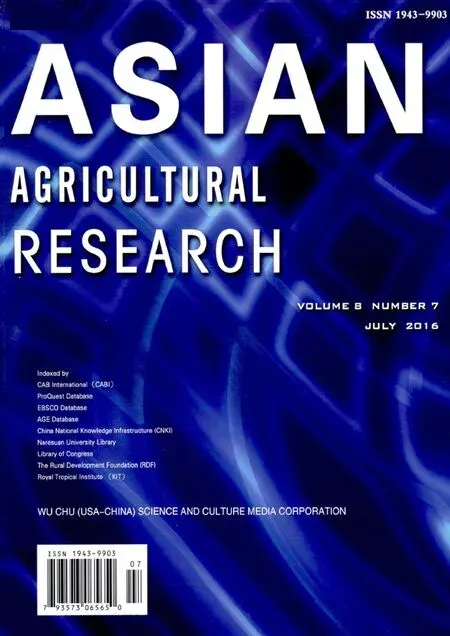Evaluation on the Competitiveness of the Agribusiness with Plateau Characteristics in Yunnan Province Based on AHP
2016-01-12,,
, ,
1. College of Economics and Management, Yunnan Agricultural University, Kunming 650201, China; 2. Yunnan Plateau Agricultural Industry Research Institute, Yunnan 650201, China
1 Introduction
Characteristic agriculture refers to the market-oriented agriculture with regional characteristics, which makes full use of various economic and geographical advantages, and is formed based on the geographical division of the national economy. In September 2012, Yunnan Provincial People’s Government issuedDecisionsonAcceleratingtheDevelopmentoftheAgriculturewith Plateau Characteristics, which clearly stated that the development of the agriculture with plateau characteristics was of great significance to improving the quality and efficiency of agricultural development in Yunnan Province, enhancing the market competitiveness of agricultural products, improving rural people’s livelihood, promoting the socialist new rural construction, and pushing forward the province’s scientific, harmonious and great-leap-forward development. With the acceleration of agricultural industrialization, the characteristic agriculture in Yunnan Province has shifted from sporadic development to large-scale development and then to initial formation of characteristic industry belt, from traditional extensive cultivation to the cultivation relying on science and technology. The cultivation scale, industrial base and market impact of the agriculture with plateau characteristics in Yunnan Province are increasingly expanding, and the integration advantages of the industries with plateau characteristics loom large. The agribusiness with plateau characteristics is an important carrier for building new agricultural management system, and a key link to promote agricultural industrialization. As of December 2013, the number of leading agribusinesses reached 2734 in Yunnan Province, and the sales income reached 155.6 billion yuan. In 2013, there were 558 leading agribusinesses above the provincial level in Yunnan Province, and the sales income reached 99.2 billion yuan. In the new normal economic context, the business environment is becoming increasingly complex and dynamic, and the "inferiority" of agriculture is enlarged, so the business risk is increasing, and the enhancement role of business competitiveness is becoming increasingly prominent. In this paper, we study the evaluation system for the competitiveness of the agriculture with plateau characteristics, evaluate the competitiveness of the agribusiness with plateau characteristics, identify the key factors that restrict business competitiveness, and explore the strategies for promotion of the competitiveness of the agribusiness with plateau characteristics, which is of practical and important significance.
2 Definition of related concepts
2.1ThecompetitivenessoftheagribusinesswithplateaucharacteristicsThe competitiveness of the agribusiness with plateau characteristics is the irreplaceable, heterogeneous, dynamic, value-added and integrated comprehensive ability of the agribusiness engaged in the agricultural production and operation with plateau characteristics compared with its competitors. It includes not only real competitiveness, but also potential competitiveness, covering corporate financial management, marketing, technology research and development, production management, organizational management, human resource management, corporate social responsibility and many other capacity dimensions.
2.2AHPThe analytic hierarchy process (AHP) is a structured technique for organizing and analyzing complex decisions, based on mathematics and psychology. It was developed by Thomas L. Saaty in the 1970s and has been extensively studied and refined since then. It has particular application in group decision making, and is used around the world in a wide variety of decision situations, in fields such as government, business, industry, healthcare, shipbuilding and education. AHP helps decision makers find one that best suits their goal and their understanding of the problem. It provides a comprehensive and rational framework for structuring a decision problem, for representing and quantifying its elements, for relating those elements to overall goals, and for evaluating alternative solutions.
3 Competitiveness evaluation of the agribusiness with plateau characteristics
3.1DesignofsurveyandresearchmaterialsBased on the literature research and early interviews, we develop Questionnaire about the Competitiveness of the Agribusiness with Plateau Characteristics in Yunnan Province, which consists of 4 parts, and 241 questions. The first part is the survey of basic information, involving property rights organization form of sample business, product unit, business level and agricultural industrialization mode. The second part shows the qualitative evaluation items of competitiveness of agribusiness with plateau characteristics, and multiple-choice is used to collect the information about corporate strategic ability, organizational design and division of labor, improvement degree of management system, organizational ability to expand outward, corporate culture adaptability, reasonable proposal adoption and employee’s satisfaction. The third part shows the quantitative evaluation items of competitiveness of agribusiness with plateau characteristics, and the form is used to collect the sample business data about human resources, corporate culture, technology development, finance, agricultural marketing, agricultural production and social responsibility performance during 2012-2014. The fourth part uses the open-ended questions to get sample businesses’ additional remark about business competitiveness.
3.2SurveyandresearchobjectThe agriculture with plateau characteristics in Yunnan Province refers to the market-oriented agriculture with regional characteristics, which is formed on the basis of national economic and geographical division of labor, including flowers, tea, coffee, herbs, plateau animal husbandry and other industries. Yunnan Plateau Characteristic Agricultural Industry Research Institute made a survey of 76 sample businesses from January to March 2015, recovered the questionnaires regarding 48 sample businesses, and selected 26 businesses as the key samples for the competitiveness evaluation of the agribusiness with plateau characteristics. For the principle of confidentiality, we omit the real name of the businesses, and only use the code. The information about the 26 sample businesses can be shown in Table 1. For the 26 agribusinesses with plateau characteristics, the form of property rights organization is dominated by private business and limited liability company, accounting for more than 90% of the total samples. There are 4 national leading enterprises, and 9 provincial agricultural enterprises, accounting for half of the total samples. In terms of agricultural product category, there are 6 product units with plateau characteristics (Yunnan medicine; Yunnan flower; Yunnan tea; Yunnan coffee; mushroom; characteristic chicken). As to the agricultural industrialization mode, the majority of businesses adopt the "leading enterprises + base + farmers" mode, accounting for 76.38% of total sample businesses.
Table1Basicinformationof26sampleagribusinesseswithplateaucharacteristics
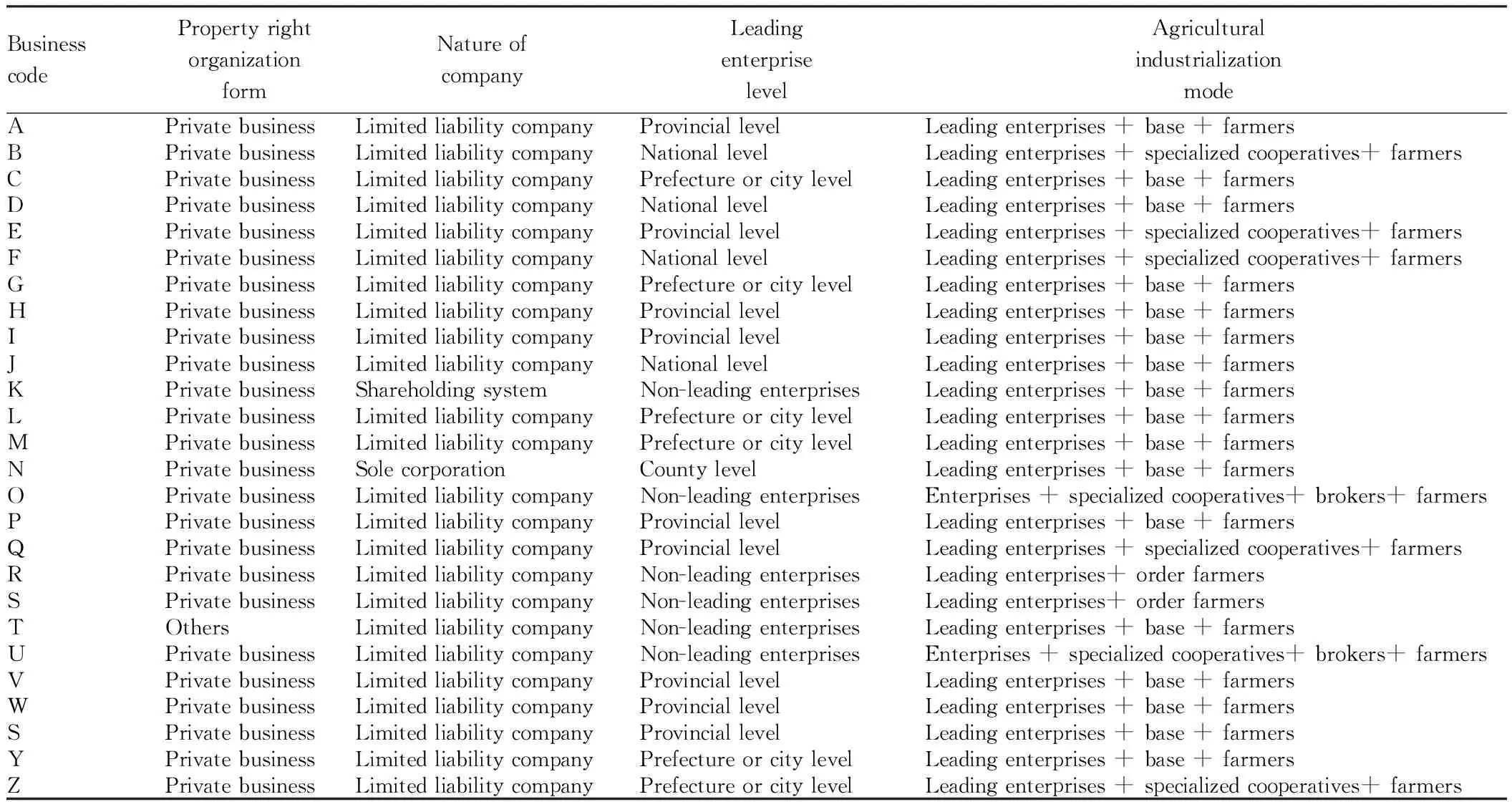
BusinesscodePropertyrightorganizationformNatureofcompanyLeadingenterpriselevelAgriculturalindustrializationmodeAPrivatebusinessLimitedliabilitycompanyProvinciallevelLeadingenterprises+base+farmersBPrivatebusinessLimitedliabilitycompanyNationallevelLeadingenterprises+specializedcooperatives+farmersCPrivatebusinessLimitedliabilitycompanyPrefectureorcitylevelLeadingenterprises+base+farmersDPrivatebusinessLimitedliabilitycompanyNationallevelLeadingenterprises+base+farmersEPrivatebusinessLimitedliabilitycompanyProvinciallevelLeadingenterprises+specializedcooperatives+farmersFPrivatebusinessLimitedliabilitycompanyNationallevelLeadingenterprises+specializedcooperatives+farmersGPrivatebusinessLimitedliabilitycompanyPrefectureorcitylevelLeadingenterprises+base+farmersHPrivatebusinessLimitedliabilitycompanyProvinciallevelLeadingenterprises+base+farmersIPrivatebusinessLimitedliabilitycompanyProvinciallevelLeadingenterprises+base+farmersJPrivatebusinessLimitedliabilitycompanyNationallevelLeadingenterprises+base+farmersKPrivatebusinessShareholdingsystemNon-leadingenterprisesLeadingenterprises+base+farmersLPrivatebusinessLimitedliabilitycompanyPrefectureorcitylevelLeadingenterprises+base+farmersMPrivatebusinessLimitedliabilitycompanyPrefectureorcitylevelLeadingenterprises+base+farmersNPrivatebusinessSolecorporationCountylevelLeadingenterprises+base+farmersOPrivatebusinessLimitedliabilitycompanyNon-leadingenterprisesEnterprises+specializedcooperatives+brokers+farmersPPrivatebusinessLimitedliabilitycompanyProvinciallevelLeadingenterprises+base+farmersQPrivatebusinessLimitedliabilitycompanyProvinciallevelLeadingenterprises+specializedcooperatives+farmersRPrivatebusinessLimitedliabilitycompanyNon-leadingenterprisesLeadingenterprises+orderfarmersSPrivatebusinessLimitedliabilitycompanyNon-leadingenterprisesLeadingenterprises+orderfarmersTOthersLimitedliabilitycompanyNon-leadingenterprisesLeadingenterprises+base+farmersUPrivatebusinessLimitedliabilitycompanyNon-leadingenterprisesEnterprises+specializedcooperatives+brokers+farmersVPrivatebusinessLimitedliabilitycompanyProvinciallevelLeadingenterprises+base+farmersWPrivatebusinessLimitedliabilitycompanyProvinciallevelLeadingenterprises+base+farmersSPrivatebusinessLimitedliabilitycompanyProvinciallevelLeadingenterprises+base+farmersYPrivatebusinessLimitedliabilitycompanyPrefectureorcitylevelLeadingenterprises+base+farmersZPrivatebusinessLimitedliabilitycompanyPrefectureorcitylevelLeadingenterprises+specializedcooperatives+farmers
Data source: Questionnaire about the Competitiveness of the Agribusiness with Plateau Characteristics in Yunnan Province.
4 Competitiveness evaluation of the agribusiness with plateau characteristics based on AHP
4.1AHPsteps
4.1.1Establishing the judgment matrix for competitiveness evaluation hierarchy. Based on literature research, business survey and expert advice, we establish the competitiveness hierarchy evaluation indicator structure for the agribusiness with plateau characteristics in Yunnan Province, which consists of 6 first-level indicators and 22 third-level indicators. According to the relative importance between indicators at various levels, we establish the judgment matrix of criteria layer and indicator layer.
4.1.2Determining the weight of indicators at various levels.In April 2015, we developExpertJudgmentMatrixQuestionnaireontheCompetitivenessEvaluationoftheAgribusinesswithPlateauCharacteristicsinYunnanProvince, and combine expert interviews with questionnaires, to consult nine agricultural economics and business management experts from Yunnan Agricultural University and Yunnan University of Finance about the weight of indicators at various levels. By matrix operation and consistency test, we get the weight of criteria layer and indicator layer of agribusiness competitiveness evaluation. The analysis results are shown in Table 2 to 8.
Table2ThecriterialayerjudgmentmatrixA-B

BusinesscompetitivenessevaluationFinancialoperationabilityMarketingcapabilityTechnologydevelopmentcapabilityProductioncapacityHumanresourceandorganizationalmanagementcapacityCorporatesocialresponsibilityWeightFinancialoperationability1.00001.49182.22552.22552.71834.05520.2979Marketingcapability0.67031.00001.49182.71833.32014.05520.2607Technologydevelopmentcapability0.44930.67031.00001.49181.82212.22550.1581Productioncapacity0.44930.36790.67031.00002.22553.32010.1384Humanresourcecapacity0.36790.30120.54880.44931.00001.82210.0868Corporatesocialresponsibility0.24660.24660.44930.30120.54881.00000.0582
Note: Consistency ratio of judgment matrix (0.0199); weight of overall goal (1.0000).
Table3TheindicatorlayerjudgmentmatrixB1-C

FinancialoperationabilityRateofreturnoncommonstockh-oldersequityTurnoveroftotalcapitalAnnualprofitgrowthrateofagriculturalindustryAsset-liabilityratioCurrentratioWeightRateofreturnoncommonstockholdersequity1.00002.71834.05523.32014.95300.4544Turnoveroftotalcapital0.36791.00002.22551.82212.71830.2125Annualprofitgrowthrateofagriculturalindustry0.24660.44931.00000.36792.22550.0994Asset-liabilityratio0.30120.54882.71831.00002.71830.1672Currentratio0.20190.36790.44930.36791.00000.0666
Note: Consistency ratio of judgment matrix (0.0347); weight of overall goal (0.2979).
Table4TheindicatorlayerjudgmentmatrixB2-C

MarketingcapabilityMarketshareofmaincharacteristicagriculturalproductsRateofreturnonsalesofmajoragriculturalindustryBrandvalueofmaincharacteristicagriculturalproductsProportionofsalesmanofmainagriculturalproductsWeightMarketshareofmaincharacteristicagriculturalproducts1.00002.71834.05524.95300.5299Rateofreturnonsalesofmajoragriculturalindustry0.36791.00002.22553.32010.2503Brandvalueofmaincharacteristicagriculturalproducts0.24660.44931.00002.71830.1444Proportionofsalesmanofmainagriculturalproducts0.20190.30120.36791.00000.0754
Note: Consistency ratio of judgment matrix (0.0359); weight of overall goal (0.2607).
Table5TheindicatorlayerjudgmentmatrixB3-C

TechnologydevelopmentcapabilityProportionofR&DexpendituretosalesThenumberofpatentsgrantedProportionofR&DpersonnelWeightProportionofR&Dexpendituretosales1.00002.71834.05520.6112Thenumberofpatentsgranted0.36791.00002.22550.2569ProportionofR&Dpersonnel0.24660.44931.00000.1319
Note: Consistency ratio of judgment matrix (0.0171); weight of overall goal (0.1581).
Table6TheindicatorlayerjudgmentmatrixB4-C

ProductioncapacityProductpercentofpassStandardizationlevelofbusinessproductionEfficientutilizationofproductioncapacityWeightProductpercentofpass1.00000.30121.82210.2348Standardizationlevelofbusinessproduction3.32011.00002.71830.5970Efficientutilizationofproductioncapacity0.54880.36791.00000.1682
Note: Consistency ratio of judgment matrix (0.0688); weight of overall goal (0.1384).
Table7TheindicatorlayerjudgmentmatrixB5-C

HumanresourcecapacityOverallqualityofmanagementpersonnelPercapitalaborprodu-ctivityClarityofstrategicgoalImprovementlevelofmanag-ementsystemWeightOverallqualityofmanagementpersonnel1.00002.71831.82211.00000.3402Percapitalaborproductivity0.36791.00000.44930.36790.1132Clarityofstrategicgoal0.54882.22551.00000.54880.2063Improvementlevelofmanagementsystem1.00002.71831.82211.00000.3402
Note: Consistency ratio of judgment matrix (0.0075); weight of overall goal (0.0868).
Table8TheindicatorlayerjudgmentmatrixB6-C

CorporatesocialresponsibilityTotalannualremunerationpaidbybusinessperemployeeNumberofcontractingfarmersPercapitaannualtaxespaidbybusinessWeightTotalannualremunerationpaidbybusinessperemployee1.00000.36790.54880.1721Numberofcontractingfarmers2.71831.00002.71830.5713Percapitaannualtaxespaidbybusiness1.82210.36791.00000.2567
Note: Consistency ratio of judgment matrix (0.0386); weight of overall goal (0.0582).
4.1.3Building hierarchical evaluation indicator system for the competitiveness of the agribusinesses with plateau characteristics in Yunnan Province. Based on the revision and perfection of experts’ opinions, we form the hierarchical evaluation indicator system for the competitiveness of the agribusinesses with plateau characteristics in Yunnan Province, as shown in Table 9.
Table9Hierarchicalevaluationindicatorsystem
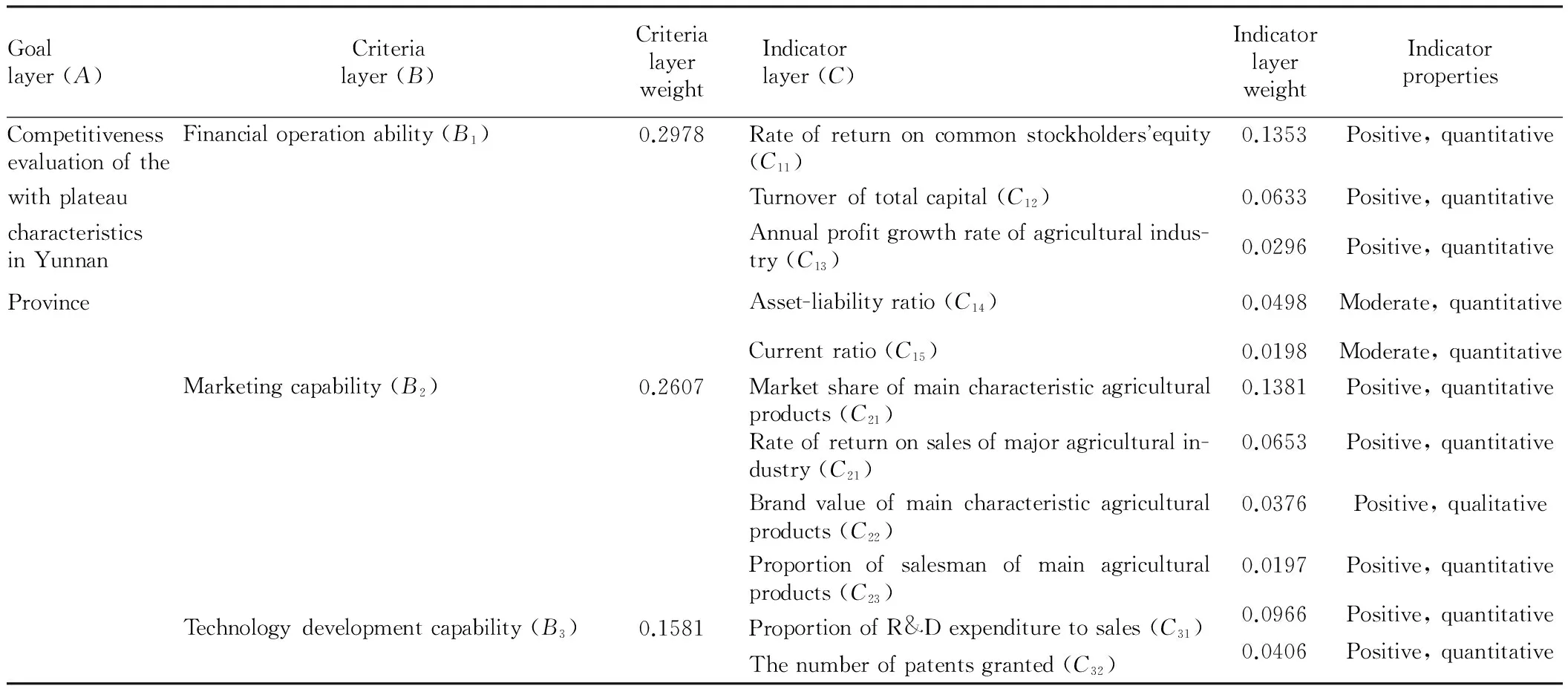
Goallayer(A)Criterialayer(B)CriterialayerweightIndicatorlayer(C)IndicatorlayerweightIndicatorpropertiesCompetitivenessevaluationoftheFinancialoperationability(B1)0.2978Rateofreturnoncommonstockholdersequity(C11)0.1353Positive,quantitativewithplateauTurnoveroftotalcapital(C12)0.0633Positive,quantitativecharacteristicsinYunnanAnnualprofitgrowthrateofagriculturalindus-try(C13)0.0296Positive,quantitativeProvinceAsset-liabilityratio(C14)0.0498Moderate,quantitativeCurrentratio(C15)0.0198Moderate,quantitativeMarketingcapability(B2)0.2607Marketshareofmaincharacteristicagriculturalproducts(C21)0.1381Positive,quantitativeRateofreturnonsalesofmajoragriculturalin-dustry(C21)0.0653Positive,quantitativeBrandvalueofmaincharacteristicagriculturalproducts(C22)0.0376Positive,qualitativeProportionofsalesmanofmainagriculturalproducts(C23)0.0197Positive,quantitativeTechnologydevelopmentcapability(B3)0.1581ProportionofR&Dexpendituretosales(C31)0.0966Positive,quantitativeThenumberofpatentsgranted(C32)0.0406Positive,quantitative
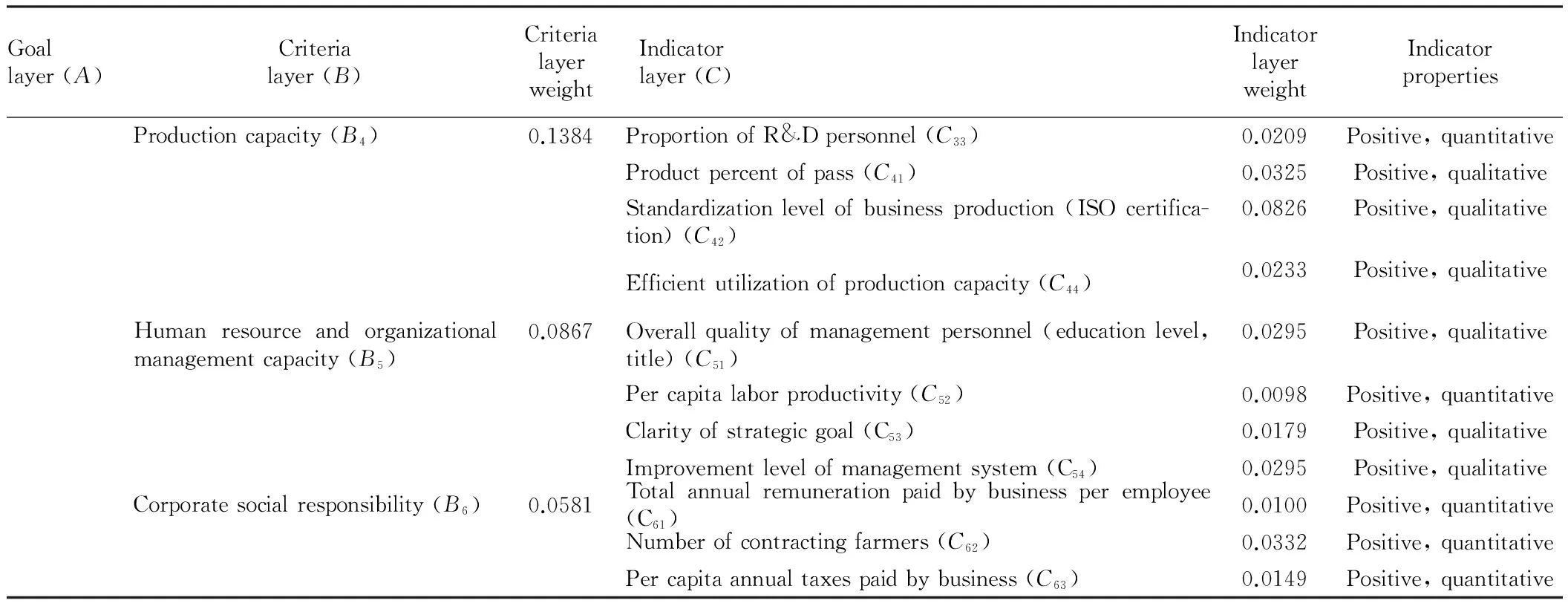
Goallayer(A)Criterialayer(B)CriterialayerweightIndicatorlayer(C)IndicatorlayerweightIndicatorpropertiesProductioncapacity(B4)0.1384ProportionofR&Dpersonnel(C33)0.0209Positive,quantitativeProductpercentofpass(C41)0.0325Positive,qualitativeStandardizationlevelofbusinessproduction(ISOcertifica-tion)(C42)0.0826Positive,qualitativeEfficientutilizationofproductioncapacity(C44)0.0233Positive,qualitativeHumanresourceandorganizationalmanagementcapacity(B5)0.0867Overallqualityofmanagementpersonnel(educationlevel,title)(C51)0.0295Positive,qualitativePercapitalaborproductivity(C52)0.0098Positive,quantitativeClarityofstrategicgoal(C53)0.0179Positive,qualitativeImprovementlevelofmanagementsystem(C54)0.0295Positive,qualitativeCorporatesocialresponsibility(B6)0.0581Totalannualremunerationpaidbybusinessperemployee(C61)0.0100Positive,quantitativeNumberofcontractingfarmers(C62)0.0332Positive,quantitativePercapitaannualtaxespaidbybusiness(C63)0.0149Positive,quantitative
4.2AHPevaluationresults
4.2.1Competitiveness evaluation results of the sample agribusinesses with plateau characteristics in Yunnan Province. According to expert judgment matrix, we calculate the weight of competitiveness evaluation indicators for the agribusiness with plateau characteristics, and calculate the score of 6 second-level indicators regarding the 26 agribusinesses (financial operation ability; marketing capability; technology development capability; production capacity; human resource and organizational management capacity; corporate social responsibility), respectively, as well as the weight of the 6 second-level indicators. Then we calculate the comprehensive competitiveness index of the 26 characteristic sample agribusinesses. In order to compare the indicator values of the sample businesses, we conduct dimensionless processing on the single competitiveness index and comprehensive competitiveness index of 26 sample businesses with plateau characteristics. The dimensionless processing formula is as follows:
Ultimately, the index of different levels of competitiveness evaluation indicators for 26 sample agribusinesses with plateau characteristics and the ranking are shown in Table 10.
Table10Indexofdifferentlevelsofcompetitivenessevaluationindicatorsandtheranking
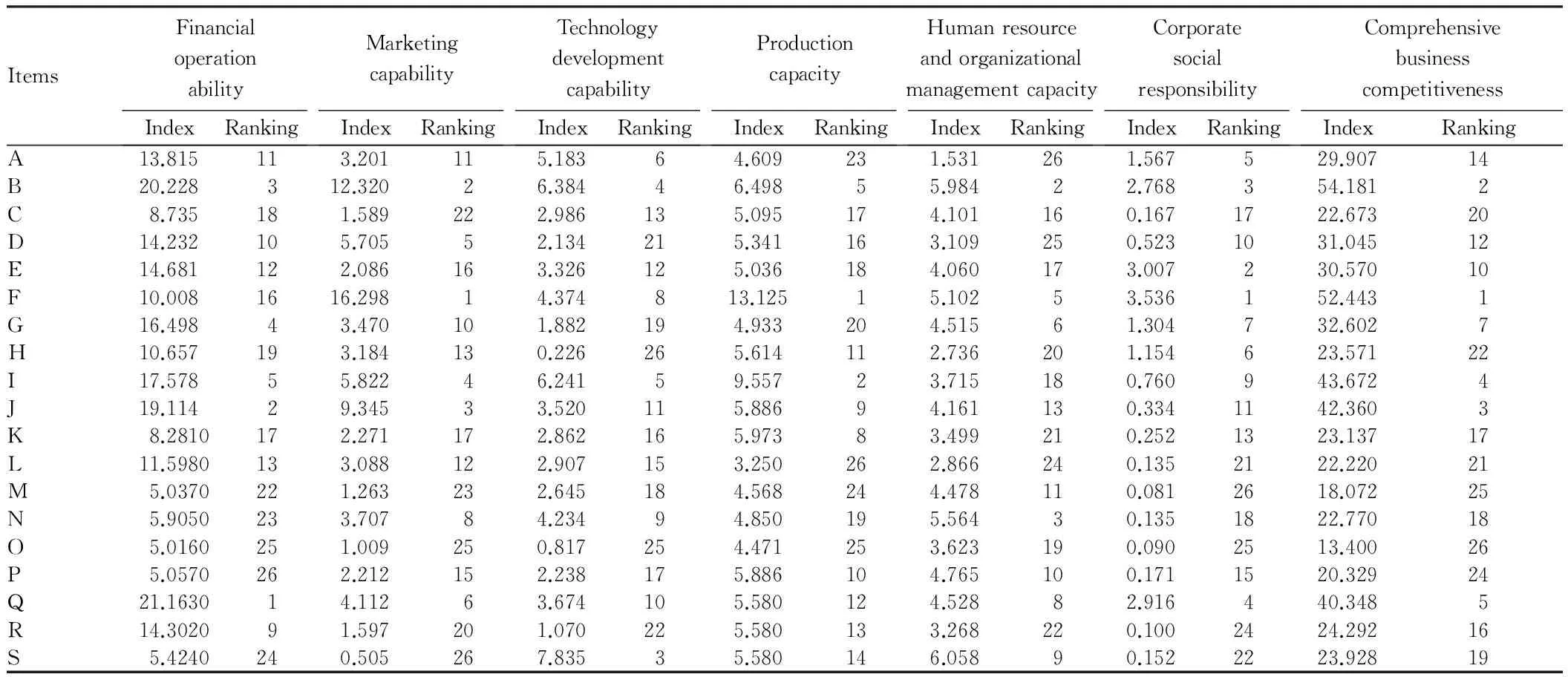
ItemsFinancialoperationabilityIndexRankingMarketingcapabilityIndexRankingTechnologydevelopmentcapabilityIndexRankingProductioncapacityIndexRankingHumanresourceandorganizationalmanagementcapacityIndexRankingCorporatesocialresponsibilityIndexRankingComprehensivebusinesscompetitivenessIndexRankingA13.815113.201115.18364.609231.531261.567529.90714B20.228312.32026.38446.49855.98422.768354.1812C8.735181.589222.986135.095174.101160.1671722.67320D14.232105.70552.134215.341163.109250.5231031.04512E14.681122.086163.326125.036184.060173.007230.57010F10.0081616.29814.374813.12515.10253.536152.4431G16.49843.470101.882194.933204.51561.304732.6027H10.657193.184130.226265.614112.736201.154623.57122I17.57855.82246.24159.55723.715180.760943.6724J19.11429.34533.520115.88694.161130.3341142.3603K8.2810172.271172.862165.97383.499210.2521323.13717L11.5980133.088122.907153.250262.866240.1352122.22021M5.0370221.263232.645184.568244.478110.0812618.07225N5.9050233.70784.23494.850195.56430.1351822.77018O5.0160251.009250.817254.471253.623190.0902513.40026P5.0570262.212152.238175.886104.765100.1711520.32924Q21.163014.11263.674105.580124.52882.916440.3485R14.302091.597201.070225.580133.268220.1002424.29216S5.4240240.505267.83535.580146.05890.1522223.92819

ItemsFinancialoperationabilityIndexRankingMarketingcapabilityIndexRankingTechnologydevelopmentcapabilityIndexRankingProductioncapacityIndexRankingHumanresourceandorganizationalmanagementcapacityIndexRankingCorporatesocialresponsibilityIndexRankingComprehensivebusinesscompetitivenessIndexRankingT6.7540201.5062111.70215.580156.07440.1691630.1619U6.0770211.1522410.01029.25134.411140.1521927.80315V15.253063.52791.447237.72143.987150.2161432.1518W15.281073.79574.86174.721214.66970.3321233.6586X15.287082.410143.028146.49862.972230.1062030.30011Y10.9320151.964182.077205.99177.12110.984827.44613Z10.4230141.744191.152244.684223.938120.1112318.80223Mean11.82063.80323.80065.995364.26290.816229.6862
4.3HierarchicalorderingofcompetitivenessofthesampleagribusinesseswithplateaucharacteristicsinYunnanProvinceAccording to AHP and dimensionless treatment results of comprehensive sample business competitiveness index, combined with the survey and research data, the competitiveness of 26 sample businesses is divided into four grades (A, B, C, D), as shown in Table 11.
Table11Comprehensiveevaluationgradingofcompetitivenessof26sampleagribusinesses

GradingofbusinesscompetitivenessBusinesscodeNumberofbusinessesClassA(excellent)B,F2ClassB(good)J,I,Q3ClassC(Average)W,G,V,D,E,Y,A7ClassD(tobeincreaseddramatically)T,U,Z,R,S,H,K,N,C,L,P,X,M,O14
5 Comprehensive analysis of the competitiveness of agribusinesses with plateau characteristics in Yunnan Province
5.1LowlevelofoverallcompetitivenessandunbalancedbusinessdevelopmentThe average comprehensive competitiveness index of 26 sample agribusinesses with plateau characteristics in Yunnan Province is 29.6862. Only 2 businesses have the comprehensive competitiveness index of above 50, accounting for 5.88% of the total sample companies; 3 businesses have index of 40-50, accounting for 11.11 % of total samples; 7 businesses have index of 30-40, accounting for 25.93 % of total samples; 11 businesses have index of 20-30, accounting for 42.31% of total samples. 80.77% of the sample businesses have comprehensive competitiveness index of below 40, and the overall level of competitiveness is low.
5.2WeakbusinessprofitabilityandobviousindustrialweaknessofagricultureAgribusiness has a long production cycle, and the unique "cobweb model" of agricultural products affects the balance of supply and demand of agricultural products. The return on assets of the agricultural industry is generally low, and for the 26 sample agribusiness with plateau characteristics, some key indicators, such as rate of return on common stockholders’equity and rate of return on sales of major agricultural industry, have low mean. Weak profitability highlights the constraints of "Engel’s Law" on the agriculture with plateau characteristics and reveals its "weakness".
5.3InadequatebrandbuildingofagriculturalproductsandweakmarketimpactThe marketing capability index mean of the sample agribusinesses with plateau characteristics in Yunnan Province is 3.8082, and 20 businesses have index below average, accounting for 76.92% of total samples. It indicates that for most sample enterprises, the brand building of agricultural products is backward, the marketing channels are limited, and market development capability is weak, thereby affecting corporate profitability and overall competitiveness.
5.4WeaktechnologicalinnovationcapabilityandlowaddedvalueofproductsThe technology development capability index mean of the sample businesses is 3.8006, and 17 businesses have this index below average, accounting for 65.38% of total samples. For most sample businesses, the technology development capability index is 3.0000 or less. It leads to low overall level of agribusiness industrialization, short industrial chain, low technological content, high degree of homogeneity and low profit margins, and the agricultural products stay mostly at the initial processing stage.
5.5LackofhumancapitalandimperfectmodernenterprisemanagementmechanismThe index mean of human resource and organizational management capacity is 4.26288, and 13 sample businesses have this index below average, accounting for half of total samples. Among 26 sample businesses with plateau characteristics in Yunnan Province, private businesses account for 96.15% of total samples, the business investment is mainly based on the entrepreneurs’ funds, and the business scale is small. The internal management system is not perfect, it lacks effective checks and balances, and the management is loose. It also lacks scientific and rational strategic plans, easily forming short-sighted decisions and blocking sustainable development.
5.6Poorinterestcombinationperformancebetweenbusinessesandfarmersanddifficultiesinfarmers’incomegrowthFor the indicator of corporate social responsibility, a third-level indicator ("number of contracting farmers") is set. During 2012-2014, for the 26 sample businesses, the annual maximum, average and minimum number of contracting farmers was 40667, 4858 and 7, respectively, indicating that there was a significant difference in the number of contracting farmers between businesses. Based on AHP evaluation results and normalization, the annual average index of number of contracting farmers for the 26 sample agribusinesses during 2012-2014 was 0.11945, and the mode was 0.0000, demonstrating that the interest combination performance between most sample businesses and farmers is not good, and it fails to effectively increase farmers’ income.
[1] CHI ZX, WANG GH. Performance evaluation of leading agricultural enterprises from the perspective of farmers based on data from Jiangxi Province[J].Journal of Jianxi Agricultural University :Social Sciences Edition, 2011,10(3):26-33. (in Chinese).
[2] WANG ZD. Evaluation on the competitiveness of agricultural enterprises[D]. Chinese Academy of Agricultural Sciences, 2006(6):36-37.(in Chinese).
[3] NIE CX. Study on the evaluation method of enterprise’s competitiveness and its application[D]. Tianjin: Tianjin University, 2003:20-25.(in Chinese).
[4] LI WD. Research on theory and methodology of the evaluation of enterprise’s competitiveness[D].Beijing: Beijing Jiaotong University, 2007: 93-107. (in Chinese).
[5] WU ZJ. On the developing experience, problems and countermeasures of the industrialization of Yunnan plateau featured agriculture[EB/OL]. View, 2012-08-22.(in Chinese).
[6] BIAN LL, LIU AJ. Study on the competitiveness of Chinese agricultural listed companies[J].World Agriculture, 2010(9):51-53.(in Chinese).
[7] YANG MH. The leading enterprises of agriculture industrialization: Analysis on supporting theories and policies[M].Beijing: Economic Science Press, 2009,12.(in Chinese).
[8] TANG XH. Study on the enterprise performance evaluation of agricultural industrialization leading enterprises[M].Beijing: China Agriculture Press,2009.(in Chinese).
[9] JIN B. Report on Chinese enterprise competitiveness (2013)[M]. Beijing:Social Sciences Academic Press(China), 2013.(in Chinese).
[10] GUO HY, WANG ZD. Study on economic performance and enterprise competitiveness of Chinese agricultural listed companies[M]. Beijing: China Social Sciences Press, 2013.(in Chinese).
杂志排行
Asian Agricultural Research的其它文章
- How to Improve the Teaching Quality of Plant Physiology?
- Overview of Ecological Toxicity of Potassium Chlorate Pollution
- Path Choice of Rural Land Transfer in China
- A Study on the Reform of China’s Agricultural Administration System
- The Application of Acidic Electrolyzed Water to Grape Cultivation in the Southern Regions
- Recent Advance in Division of Carbohydrate and Protein Fractions of Ruminant Feed and Their Metabolism in Digestive Tract
